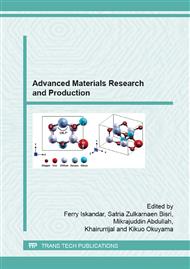p.323
p.329
p.333
p.338
p.345
p.349
p.353
p.359
p.363
Objective and Combinational Analysis of Multiple Kinds of Data Obtained from Severe-Mild Wear Transition
Abstract:
The authors have been developing objective and combinational analysis method for multiple kinds of data obtained by a repeated sliding test performed with a pin-on-disk apparatus to clarify the wear mechanisms. The developed analysis method successfully showed the growth rate and the size of adhered substances on the sliding surface for adhesive wear mechanism. In this paper, the developed method was applied for analyzing chronological changes in severe-mild wear forms transition to understand the phenomena more quantitatively. Friction force, pin specimen displacement perpendicular to the slid surface and electrical contact resistance between pin and disk specimens were employed as the multiple kinds of data. The devised analysis showed that the formation of a plateau with around 25 μm height on the slid surface is a key factor for the transition.
Info:
Periodical:
Pages:
345-348
Citation:
Online since:
July 2015
Authors:
Price:
Сopyright:
© 2015 Trans Tech Publications Ltd. All Rights Reserved
Share:
Citation:


